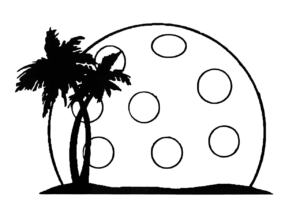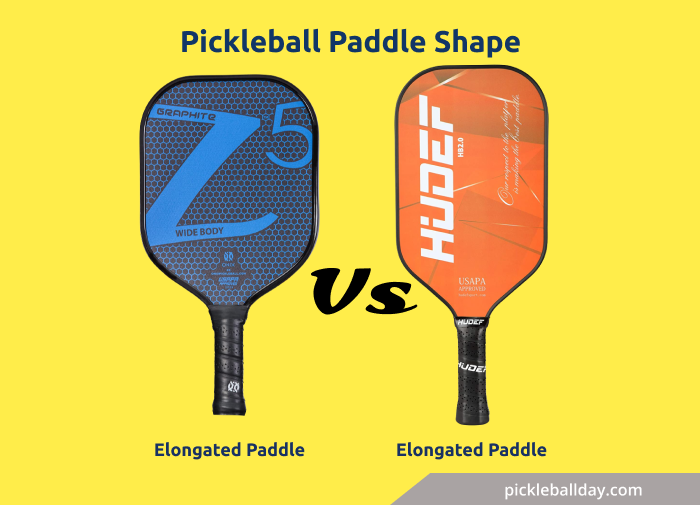In conjunction with the quality of your pickleball paddles, the level of your capability and proficiency matters for immense success in pickleball. And it’s the material that determines the efficacy. But, along with all the features of a paddle, the shape matters too. In short, paddle shape plays a vital role in overall performance.
The popularity of pickleball has enticed a lot of companies to forge the best-qualified paddles on the market. In light of this development, choosing the best pickleball paddle shape that complements your style of play becomes a bit harder.
To assist you in making a choice, we’ll look at elongated paddles vs. standard wide-body paddles. And all you need to know to make an informed decision.
Table of Contents
- 1 How Many Shapes Are Used for Pickleball Paddles
- 2 Why Are Different Shaped Paddles Used in Pickleball?
- 3 What is a Wide-Body Pickleball Paddle?
- 4 What are the Benefits of Wide-Body Pickleball Paddles?
- 5 What are the Disadvantages of Wide-Body Pickleball Paddles?
- 6 What is an Elongated Pickleball Paddle?
- 7 What are the Benefits of Elongated Pickleball Paddles?
- 8 What are the Disadvantages of Elongated Pickleball Paddles?
- 9 Pros and Cons of Wide-Body and Elongated Paddles
- 10 Elongated or Wide-body: Which pickleball paddle shape is best
- 11 All the Frequently Asked Questions About Paddle Shapes
- 12 Your Pick
How Many Shapes Are Used for Pickleball Paddles
Currently, there are only two shapes of pickleball paddles on the market: elongated pickleball paddles and standard wide-body paddles. They’re made from different dimensions and are designed with certain benefits regarding the player’s capability and style of play.
However, the shapes are regulated by the regulating body, USAPA, ensuring that the combined width and length don’t exceed the stipulated 24 inches. Specific tweaks have been made to create a variety of elongated pickleball paddles.
You’ll get the blade-shaped pickleball paddles, which are equivalent to the elongated pickleball paddles. They have a 17-inch length with a width not exceeding 7 inches. Also, there are teardrop-shaped pickleball paddles with a more rounded shape than other pickleball paddles.
This unique feature enables players to have consistent, solid contact with the pickleball, given the extended sweet spot location further up the paddle. You’ll also get tennis-shaped pickleball paddles, similar to a short tennis racquet. The tennis pickleball paddles aid a player in transitioning from tennis to pickleball.
Why Are Different Shaped Paddles Used in Pickleball?
The pickleball shapes are designed to cater to every player’s style of play, whether you enjoy the exchange at the kitchen line or a banger. The rectangular or oval-shaped paddles will cater to that.
Differences in height, width, and thickness in both paddles offer different attributes, which we will get into later on.
What is a Wide-Body Pickleball Paddle?
Designed and depicted from the initial wood paddles, they’re rectangular with much more thickness and weight. These paddles are designed with a length of 16 inches and a width of 8 inches, able to offer a larger hitting area.
What are the Benefits of Wide-Body Pickleball Paddles?
As one of the most popular paddle shapes on the market, the wide-body pickleball paddle is ideal for every player looking for an affordable option.
Since they are a bit wider than the elongated pickleball paddles, they offer a larger sweet spot. The sweet spot is squarely in the middle, given its circular center of gravity.
With its rectangular design compounded with its width, the player has the leeway to make fewer mis-hits, making it efficient for beginners.
Though these paddles may be thicker, they’re lighter, allowing players to enjoy
quick maneuverable returns on the kitchen line. Any player with a shoulder injury will enjoy using this paddle, though you may need to exert more power.
Their weight and size offer players an opportunity to improve their game to a more finesse-style game, ideal for advanced players who do not regard power as a priority.
What are the Disadvantages of Wide-Body Pickleball Paddles?
The weight of a pickleball paddle determines the amount of power it emits. Wide-body pickleball paddles are generally lighter. With a surface width of approximately 8 inches or more, the length reduces, giving you less reach.
It requires better footwork to compensate for the reach, given that the sweet spot is at the center.
What is an Elongated Pickleball Paddle?
With a larger length of 16.5 to 17 inches, the elongated pickleball paddles take an oval shape with a limited width dimension of about 7–7.5 inches, in compliance with the total regulated size.
Though this may limit the sweet spot, it offers players more reach due to its extra length. The drawback is that you’ll get a bit slower in the paddle’s maneuverability.
What are the Benefits of Elongated Pickleball Paddles?
Elongated pickleball paddles are designed with a longer length to allow players more reach as well as more court coverage, allowing them to reach the baseline. The smaller and tighter sweet spots provide an avenue for overhead smashes while also providing jumps off the paddle. It’s also ideal for spin or roll shots.
They offer a comfortable feel to other racquetball players, including tennis players, due to their length. Its aerodynamic shape allows it to cut faster through the air to provide swifter rotation.
What are the Disadvantages of Elongated Pickleball Paddles?
The most significant disadvantage of elongated paddles is their small sweet spot, courtesy of their narrower surface width. You’ll experience slow exchanges given their size, which depicts an oversized paddle that works against your mobility on the court.
Pros and Cons of Wide-Body and Elongated Paddles
| Pros of Wide-Body Paddles | Pros of Elongated Paddles |
| Quick response | Efficient rotation |
| Large sweet spot | More reach |
| Cost-effective | More power |
| Fewer mis-hits | More speed |
| Cons of Wide-Body Paddles | Cons of Elongated Paddles |
| Less power | Small sweet spot |
| Less reach | Slow exchange |
| Less control |
Elongated or Wide-body: Which pickleball paddle shape is best
Paddle Shape for Beginner Players
A wide-body paddle is better suited for a beginner given that you have a large sweet spot that allows for minimal mis-hits and a lighter paddle that allows for maneuverability.
Paddle Shape for Intermediate Players
Picking a paddle shape will most likely be influenced by your playing style. Still, the aerodynamic, spin, and swerve attributes of an elongated pickleball paddle will most likely endear you. And if you want a recommendation for an intermediate pickler, I would bet on an elongated paddle.
Paddle Shape for Advanced Players
The contention between power, finesse, maneuverability, and reach are all the things that you should consider when you are a pro-level master. As a more advanced player, you should be more concerned about finesse, not only the power, so a wide body would probably do the trick.
All the Frequently Asked Questions About Paddle Shapes
Q1: Does the pickleball paddle’s shape make a difference?
A: There’s a slight difference in terms of play, which can only be capitalized given your style of play. Your wits, capability, and skills are what count more than the shape of the paddle you choose.
Q2: Are elongated pickleball paddles good for experts?
A: Yes, given your playing style, you’ll get more power, reach, and more tricks up your sleeve as you’ll be able to get more spin and swerve off the ball. Their small sweet spot, thin shape, and short handles endear to only several players.
Q3: Who should use an elongated pickleball paddle?
A: Despite their growing popularity, they’re still regarded as specialty paddles ideal for elite players. Though, you’ll sacrifice the ability to get softer shots and control dinks.
Q4: Are elongated pickleball paddles legal?
A: Yes, the USAPA has put regulatory measures that require elongated-shaped paddles to have a maximum length of 17 inches. To maximize the length they need, manufacturers sometimes opt for short handles appealing to players who prefer fingers protruding on the paddle surface.
Q5: How long is an Elongated Pickleball Paddle?
A: 17 inches is the stipulated length measurement that each manufacturer has to abide by.
Q6: Is a wider pickleball paddle better?
A: It’s better if you’re looking for a large sweet spot, maneuverability, and finesse. However, opting for this paddle will have to show exceptional footwork ability to compensate for the reach drawback.
Your Pick
Having gone through the comparison between the elongated paddle and the standard wide-body pickleball paddle, I’m optimistic you’ve gained the knowledge to get the best pickleball paddle that suits your playing style.


